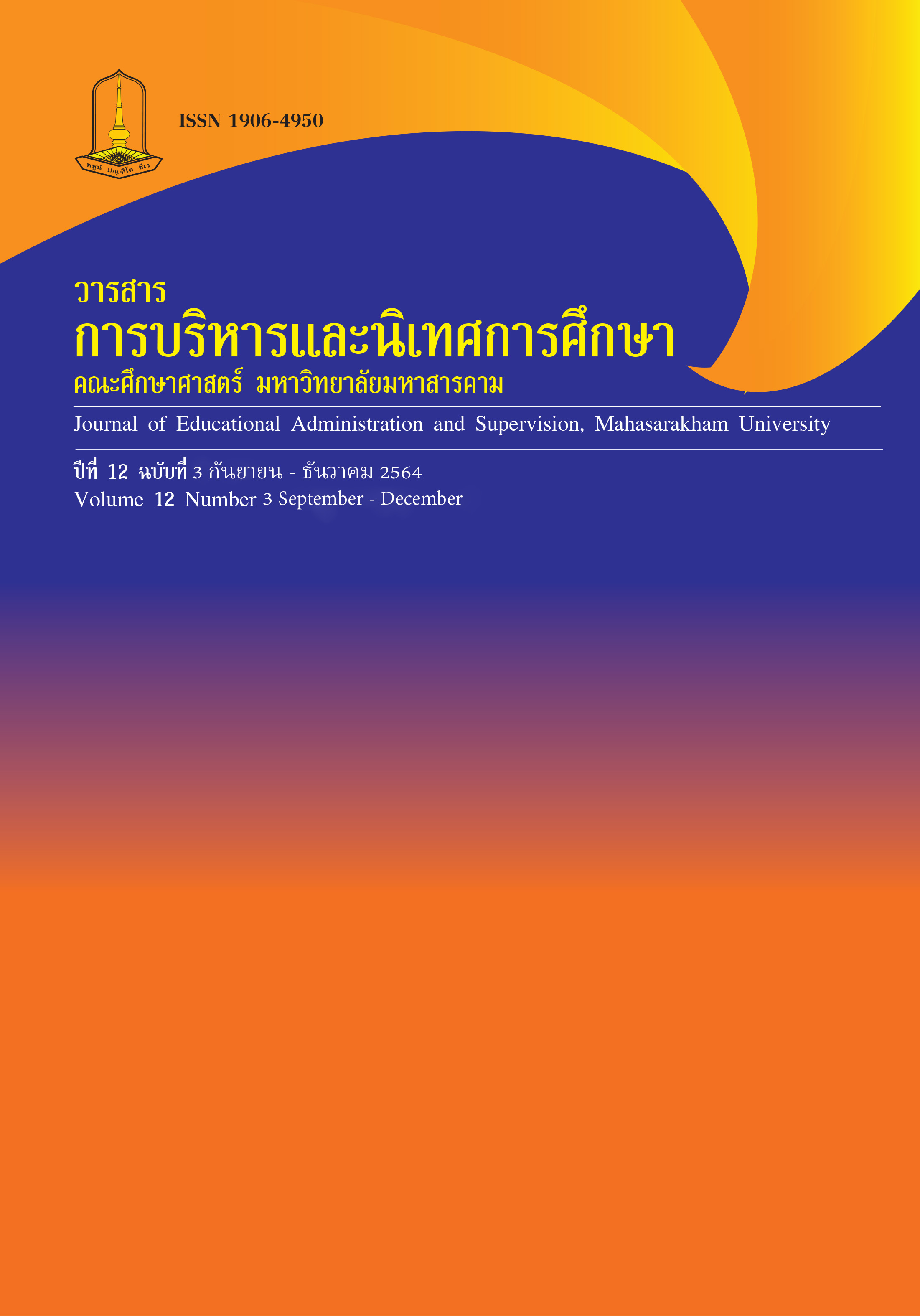Development of Learning Organization Guidelines for Extended Opportunity Schools under Khon Kaen Primary Educational Service Area Office 5
Main Article Content
Abstract
The study aimed to 1) study the current condition, desirable condition and necessity of developing of learning organization guidelines for extended opportunity schools under Khon Kaen primary educational service area office 5 and 2) to develop guidelines of learning organization for Extended Opportunity Schools under Khon Kaen Primary Educational Service Area Office 5. The study was conducted in 2 phases: phase 1, the current condition and desirable condition were studied from 341 school directors and teachers as the sample group in extended opportunity schools under Khon Kaen primary educational service area office 5 in academic year 2020 using questionnaires as research instrument. During phase 2, the guidelines of learning organization in extended opportunity schools under Khon Kaen primary educational service area office 5 were developed by the school directors with best practices using interview as research instrument and were assessed by 5 experts.
The findings show that 1) the current condition of developing of learning organization guidelines for extended opportunity schools under Khon Kaen primary educational service area office 5 overall is at high level, the desirable condition is very high
2) The guidelines of learning organization for extended opportunity schools under Khon Kaen primary educational service area office 5 with prior necessity are technology utilization 6 guidelines, system thinking 6 guidelines, mental model 6 guidelines, personal mastery 6 guidelines, shared vision 5 guidelines and team learning 5 guidelines, respectively.
Downloads
Article Details
References
จิรประภา อัครบวร. (2554). พัฒนาคน บนความยั่งยืน กรุงเทพฯ: เต้า (2000).
ฐิติพร พิบูลย์วงศ์. (2559). แนวทางการพัฒนาเป็นองค์กรแห่งการเรียนรู้ของธนาคารออมสินภาค 14.งานนิพนธ์ปริญญามหาบัณฑิต, มหาวิทยาลัยบูรพา.
นฤมล จันทร์สุข. (2554). รูปแบบและกลยุทธ์การพัฒนาการเป็นองค์การแห่งการเรียนรู้ของวิทยาลัยพยาบาล. วิทยานิพนธ์ปริญญาครุศาสตดุษฎีบัณฑิต, จุฬาลงกรณ์หมาวิทยาลัย.
นิชนันทร์ บุญสา. (2557). สภาพองค์การแห่งการเรียนรู้สู่ประชาคมอาเซียน ของโรงเรียนสังกัดสำนักงาน เขตพื้นที่การศึกษามัธยมศึกษา เขต 27. วิทยานิพนธ์ปริญญาศึกษาศาสตรมหา บัณฑิต, มหาวิทยาลัยขอนแก่น.
สุมัชฌา ปารัคมาตย์. (2557). การศึกษาวัฒนธรรมองค์กรและองค์กรแห่งการเรียนรู้ส่งผลต่อคุณภาพ ชีวิตที่ดีของพนักงานในองค์กร กรณีศึกษา ธนาคาร A สำนักงานใหญ่ (บางเขน). การค้นคว้า อิสระ, มหาวิทยาลัยกรุงเทพ.
สุวัฒน์ จุลสุวรรณ์. (2562). การบริหารการเปลี่ยนแปลงในสถานศึกษา. มหาสารคาม: ตักสิลาการพิมพ์.
เสาวภาคณ์ เชาวนะสิริยธรรม. (2560) การพัฒนาสู่องค์กรแห่งการเรียนของวิทยาลัยชุมชนเมืองแห่งกรุงเทพมหานคร. วารสารการจัดการสมัยใหม่, 15(2), 57-66.
Benett, J.K. & O'Brien, M.J. (1994). The Building Blocks of the Learning Organization.Training, 3(June), 41-49.
Fullan, M. (200 1). Leading in a culture of change. San Francisco: Jossey-Bass.
Fulmer, R.M. & Keys, J.B. (1998). A conversation with Peter Senge: New developments inorganizational learning. Organizational Dynamics, 27(2), 33-42.
Garvin, D.A. (1993). Building a Learning Organization. Harvard Business Review.
Hussein et al. (2016). Learning Organization Culture, Organizational Performance andOrganizational Innovativeness. a Public Institution of Higher Education in Malaysia:A Preliminary Study, 5 12-519.
Krejcie and Morgan. (1970). Determining Sample Size for Research Activities. Educationaland Phychological Measurement, 30, 607-610.
Marquardt, M.J. & Reynolds, A. (1994). 1995. Building The Global Learning Organization.New York.
Marquardt, M.J. (1996). Building the Learning Organization: A Systems Approach to Quantum Improvement & Global Success. New York: McGraw-Hill,Marsick, V. & Watkins, K. (2003). Demonstrating the Value of an Organization's Learning
Culture: The Dimensions of the Learning Organization Questionnaire. Advances in Developing Human Resources, 5, 133.
Senge, P. (1990). The Fifth Disciplines: The Art and Practice of the Learning Organization.
New York: Bantam Doubleday Dell Publishing Group, Inc.


